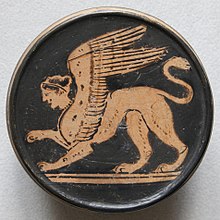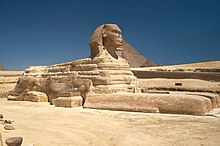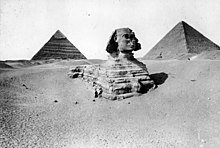| Grouping | Legendary creatures |
|---|---|
| Similar entities | Griffin, Manticore, Cherub, Lamassu, Narasimha |
| Region | Persian, Egyptian and Greek |
A sphinx (/ˈsfɪŋks/ SFINKS, Ancient Greek: σφίγξ [spʰíŋks], Boeotian: φίξ [pʰíːks], plural sphinxes or sphinges) is a mythical creature with the head of a human, the body of a lion, and the wings of an eagle.
In Greek tradition, the sphinx is a treacherous and merciless being with the head of a woman, the haunches of a lion, and the wings of a bird. According to Greek myth, she challenges those who encounter her to answer a riddle, and kills and eats them when they fail to do so.[1] This deadly version of a sphinx appears in the myth and drama of Oedipus.[2]
In Egyptian mythology, in contrast, the sphinx is typically depicted as a man (an androsphinx (Ancient Greek: ανδρόσφιγξ)), and seen as benevolent, though with strength as ferocious as that of the Greek version. Both the Greek and Egyptian sphinxes were thought of as guardians, and statues of them often flank the entrances to temples.[3]
During the Renaissance the sphinx enjoyed a major revival in European decorative art. During this period, images of the sphinx were initially similar to the ancient Egyptian version, but when later exported to other cultures, the sphinx was often conceived of quite differently, partly due to varied translations of descriptions of the originals, and partly through the evolution of the concept as it was integrated into other cultural traditions.
However, depictions of the sphinx are generally associated with grand architectural structures, such as royal tombs or religious temples.
Etymology
The word sphinx comes from the Greek Σφίγξ, associated by folk etymology with the verb σφίγγω (sphíngō), meaning "to squeeze", "to tighten up".[4][5] This name may be derived from the fact that lions kill their prey by strangulation, biting the throat of prey and holding them down until they die. However, the historian Susan Wise Bauer suggests that the word "sphinx" was instead a Greek corruption of the Egyptian name "shesepankh", which meant "living image", and referred rather to the statue of the sphinx, which was carved out of "living rock" (rock that was a contiguous part of the stony body of the Earth, shaped, but not cut away from its original source), than to the beast itself.[6]
Egypt
The largest and most famous sphinx is the Great Sphinx of Giza, situated on the Giza Plateau adjacent to the Great Pyramids of Giza on the west bank of the Nile River and facing east (29°58′31″N 31°08′15″E). The sphinx is located southeast of the pyramids. While the date of its construction is not known for certain, the general consensus among Egyptologists is that the head of the Great Sphinx bears the likeness of the pharaoh Khafre, dating it to between 2600 and 2500 BC. However, a fringe minority of late 20th century geologists have claimed evidence of water erosion in and around the Sphinx enclosure which would prove that the Sphinx predates Khafre, at around 10,000 to 5000 BC, a claim that is sometimes referred to as the Sphinx water erosion hypothesis but which has little support among Egyptologists and contradicts other evidence.[7]
What names their builders gave to these statues is not known. At the Great Sphinx site, a 1400 BC inscription on a stele belonging to the 18th dynasty pharaoh Thutmose IV lists the names of three aspects of the local sun deity of that period, Khepera–Rê–Atum. Many pharaohs had their heads carved atop the guardian statues for their tombs to show their close relationship with the powerful solar deity Sekhmet, a lioness. Besides the Great Sphinx, other famous Egyptian sphinxes include one bearing the head of the pharaoh Hatshepsut, with her likeness carved in granite, which is now in the Metropolitan Museum of Art in New York, and the alabaster Sphinx of Memphis, currently located within the open-air museum at that site. The theme was expanded to form great avenues of guardian sphinxes lining the approaches to tombs and temples as well as serving as details atop the posts of flights of stairs to very grand complexes. Nine hundred sphinxes with ram heads (Criosphinxes), believed to represent Amon, were built in Thebes, where his cult was strongest. At Karnak, each Criosphinx is fronted by a full-length statue of the pharaoh. The task of these sphinxes was to hold back the forces of evil.[8]
The Great Sphinx has become an emblem of Egypt, frequently appearing on its stamps, coins, and official documents.[9]
In March 2023, a limestone sphinx was discovered at the Dendera Temple Complex. This sphinx, which is depicted with a slight grin and dimples, is thought to be made in the image of the Roman emperor Claudius.[10]
https://en.wikipedia.org/wiki/Sphinx



No comments:
Post a Comment